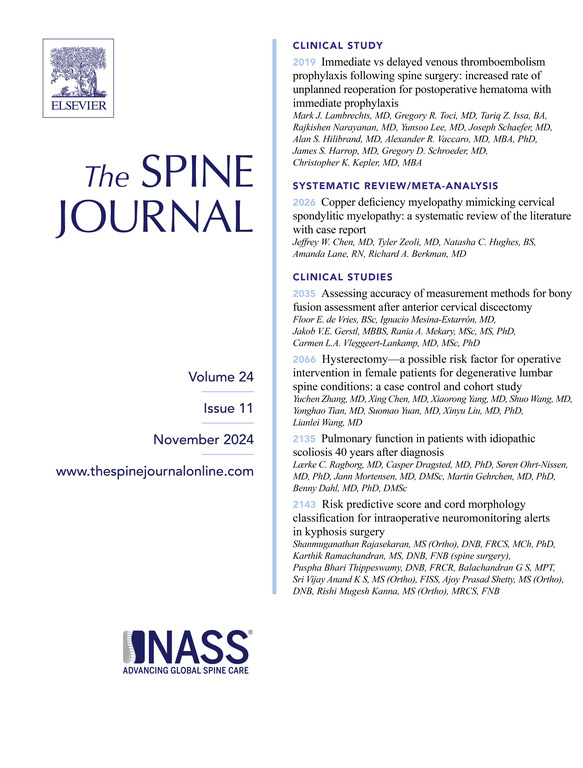Prediction of primary admission total charges following cervical disc arthroplasty utilizing machine learning
IF 4.7
1区 医学
Q1 CLINICAL NEUROLOGY
引用次数: 0
Abstract
BACKGROUND CONTEXT
Cervical disc arthroplasty (CDA) has become an increasingly popular alternative to anterior cervical discectomy and fusion, offering benefits such as motion preservation and reduced risk of adjacent segment disease. Despite its advantages, understanding the economic implications associated with varying patient and hospital factors remains critical.
PURPOSE
To evaluate how hospital size, geographic region, and patient-specific variables influence charges associated with the primary admission period following CDA.
STUDY DESIGN
A retrospective analysis using machine learning models to predict and analyze charge factors associated with CDA.
PATIENT SAMPLE
Data from the National Inpatient Sample (NIS) database from 2016 to 2020 was used, focusing on patients undergoing CDA.
OUTCOME MEASURES
The primary outcome was total charge associated with the primary admission for CDA, analyzed against patient demographics, hospital characteristics, and regional economic conditions.
METHODS
Multivariate linear regression and machine learning algorithms including logistic regression, random forest, and gradient boosting trees were employed to assess their predictive power on charge outcomes. Statistical significance was set at the 0.003 level after applying a Bonferroni correction.
RESULTS
The analysis included 3,772 eligible CDA cases. Major predictors of charge identified were hospital size and ownership type, with large and privately owned hospitals associated with higher charges (p<.001). The Western region of the U.S. also showed significantly higher charges compared to the Northeast (p<.001). The gradient boosting trees model showed the highest accuracy (AUC=85.6%). Length of stay and wage index were significant charge drivers, with each additional inpatient day increasing charges significantly (p<.001) and higher wage index regions correlating with increased charges (p<.001).
CONCLUSIONS
Hospital size, geographic region, and specific patient demographics significantly influence the charges of CDA. Machine learning models proved effective in predicting these charges, suggesting that they could be instrumental in guiding economic decision-making in spine surgery. Future efforts should aim to incorporate these models into broader clinical practice to optimize healthcare spending and enhance patient care outcomes.
利用机器学习预测颈椎间盘关节置换术后的主要入院总费用。
背景情况:颈椎间盘关节置换术(CDA)已成为颈椎前路椎间盘切除术和融合术的一种日益流行的替代方法,它具有保留运动和降低邻近节段疾病风险等优点。目的:评估医院规模、地理区域和患者特异性变量如何影响CDA术后主要入院时间段的相关费用:采用机器学习模型进行回顾性分析,预测并分析与 CDA 相关的收费因素:患者样本:采用2016年至2020年全国住院患者样本(NIS)数据库中的数据,重点关注接受CDA的患者:主要结果是与CDA主要入院相关的总费用,并根据患者人口统计学特征、医院特征和地区经济状况进行分析:方法:采用多元线性回归和机器学习算法(包括逻辑回归、随机森林和梯度提升树)来评估它们对收费结果的预测能力。应用 Bonferroni 校正后,统计显著性设定为 0.003 水平:分析包括 3,772 个符合条件的 CDA 病例。医院规模和所有制类型是费用的主要预测因素,大型医院和私营医院的费用较高(p结论:医院规模、地理区域和特定的所有制类型是费用的主要预测因素:医院规模、地理区域和特定的患者人口统计学特征对 CDA 的收费有很大影响。事实证明,机器学习模型能有效预测这些费用,这表明它们有助于指导脊柱手术的经济决策。未来的工作目标应该是将这些模型融入到更广泛的临床实践中,以优化医疗支出,提高患者的治疗效果。
本文章由计算机程序翻译,如有差异,请以英文原文为准。
求助全文
约1分钟内获得全文
求助全文
来源期刊

Spine Journal
医学-临床神经学
CiteScore
8.20
自引率
6.70%
发文量
680
审稿时长
13.1 weeks
期刊介绍:
The Spine Journal, the official journal of the North American Spine Society, is an international and multidisciplinary journal that publishes original, peer-reviewed articles on research and treatment related to the spine and spine care, including basic science and clinical investigations. It is a condition of publication that manuscripts submitted to The Spine Journal have not been published, and will not be simultaneously submitted or published elsewhere. The Spine Journal also publishes major reviews of specific topics by acknowledged authorities, technical notes, teaching editorials, and other special features, Letters to the Editor-in-Chief are encouraged.
 求助内容:
求助内容: 应助结果提醒方式:
应助结果提醒方式:


